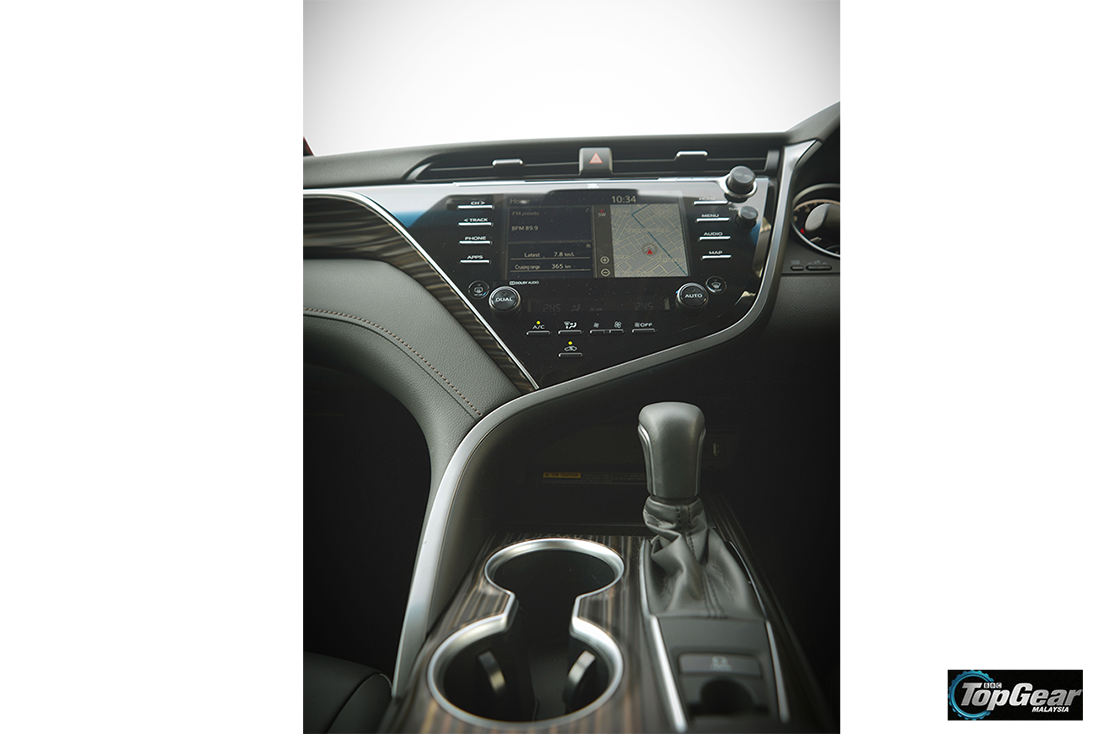Test drive: Toyota Camry 2.5V

Malaysians were making cars before they knew it. In buying more Japanese saloons than European wagons in the 70s, our forefathers inadvertently created the ‘uncle car’ segment.
The ideal of a spacious family sedan with hints of continental luxury gained prominence in the mid-90s when cars like the Honda Accord and Nissan Cefiro became status symbols within working class aspirations. And at the height of it all was the Toyota Camry.
Locally, it was the XV10 model of the 1990s that sparked the Camry’s D-segment dominance. My headmaster had one and my father dreamt of owning one, such was its appeal to the hard-working family man.
This demographic remained relatively unchanged over the years and Toyota exploited the trend with products that were largely the same as their predecessors with every generation – can you believe UMW Toyota’s flagship sedan had a four-speed auto as recently as 2015?

It was only a matter of time before consumers saw right through this low-risk, high-reward strategy. Typical Camry buyers either became pickier with their hard-earned cash or simply didn’t need a new car given Toyota’s stellar reliability track record.
Even high-tech features like wireless charging and a hybrid powertrain struggled to spur sales of the recently discontinued XV50 model. That the D-segment was ailing in general didn’t help. Either way, Toyota needed a saviour – an “unprecedented change” in the words of chief engineer Masato Katsumata. And its name is XV70.
The fact that Toyota skipped a number (or ten) hints at how much has changed in the 2019 Camry. It is underpinned by the nameplate’s first new platform since 2001 after all.
The TNGA (Toyota New Global Architecture) platform is a lighter and quieter setup that’s also designed with ride and handling in mind, or so Toyota claims.
Lexus uses a variant of this platform for the LC500, so there must be some merit there. But none of this matters, at least not for now, because the most prevailing matter is how much bolder the Camry has become on the surface.
Things are especially menacing at the front, where design cues first seen in the Harrier – svelte LED headlights and a massive trapezoidal intake – are dramatised to great effect in what used to be one of the most visually predictable sedans on sale.
This is obviously no longer the case with the Camry. In fact, UMW Toyota is so confident in its new looker that it calls it a ‘Beautiful Monster’ in its marketing material. We’ll leave that one to you to interpret.
Inside, the cabin feels more executive lounge than monster’s den, with Toyota incorporating modern niceties such as a 10-inch head-up display, Qi wireless charger and nine-speaker JBL audio system tastefully into an otherwise textbook D-segment interior.
The leather is plush and fit and finish, near faultless – the quality certainly befits a car costing nearly RM200k. More importantly, it’s as roomy as you’d expect a Camry to be. As usual, there’s more space than a Merc E-Class in the back while comfort levels have also been upheld surprisingly well despite the switch to 18-inch footwear.
Though comfort-biased from the perspective of a happy passenger (you’d have to be a seven-foot grouch to not enjoy a ride in the Camry) the revised suspension also stays true to the TNGA platform’s ride and handling objectives.
Paired with the XV70’s lowered centre of gravity, the improved MacPherson strut and rear double wishbones keep the Camry’s 1.6-tonne mass in check through the corners with plenty of finesse. It’s also remarkably quiet on the move. And we can’t help but feel that 181 horses are wasted on a chassis that’s evidently capable of bigger things.
But a car as big as the Camry would definitely benefit from more low-end punch.
By 2019 standards, a sub-200bhp return on nearly RM900 worth of annual road tax doesn’t spell good business. While other markets get the newer “Dynamic Force” engine with 206bhp, UMW Toyota stands by the 2AR-FE 2.5-litre mill for Malaysia.
This means there’s just 235Nm of twist on tap, and even that’s only unlockable past 4,000rpm. The journey to get there is relatively smooth and linear in a classically naturally-aspirated fashion. But a car as big as the Camry would definitely benefit from more low-end punch.

On spirited runs, we found ourselves pushing the powertrain to keep its head above 3,500rpm quite often. This can feel unruly at times – there’s only so much the engine’s “Acoustic Control Induction System (ACIS)” can do under heavy load.
You’d imagine us pulling this off with a pair of paddle shifters, but unlike the Vios’s CVT, the Camry’s six-speed auto aren’t equipped with them. It’s a much more competent and refined transmission in every other measure. And you’d rarely need its sequential shift whichever way you choose to drive the Camry.
All things considered, Toyota’s long-time D-segment favourite has been vastly revitalised by its newfound aesthetic and dynamic panache.
It is, without a speck of doubt, the most exciting Camry ever made. We’ve certainly enjoyed the way it looks and drives for the most part. But it’s also easy to lose sight of the car’s true purpose amidst the shock and awe.
At the core is still a traditional executive saloon with almost every quality you’d expect a family car to possess. This is a thoroughly improved Camry in that respect. The salaryman’s dream car has never been better.
All-new Camry gives you a lot of car for a lot of money. Accommodating chassis is surprisingly driver-oriented too.
Volkswagen Passat 2.0TSI
Vee-Dub’s closely-priced range-topper is the true benchmark for out-and-out performance.
SPECS
| Engine | 2,494cc, 4-cyl DOHC with dual VVT-i, 181bhp, 235Nm |
| Price | RM189,900 |
| Performance | NA |
| Economy | NA |
| Weight | 1,550kg |



